Text
Australian Music Vault

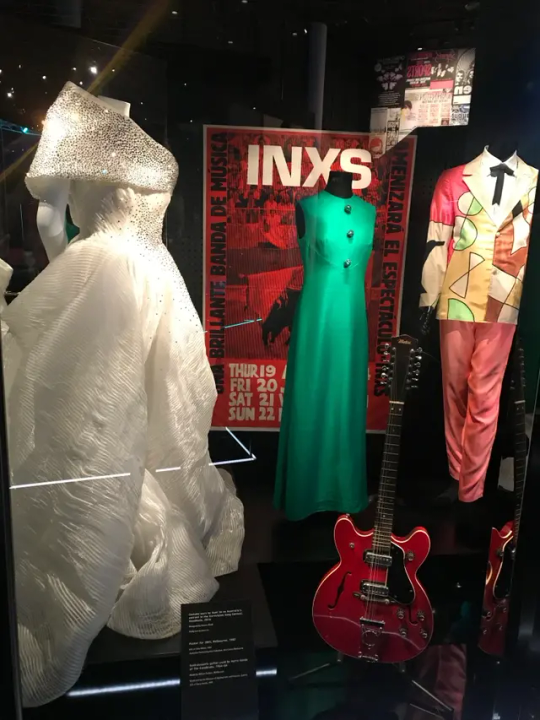
[1] [2] Australian Music Vault (2019) [Exhibition] Arts Centre Melbourne, Melbourne. 2017-Present.
The Australian Music Vault – an institution dedicated to the conservation and display of archival materials culturally significant to the music scene in Australia. Located within the Arts Centre in Melbourne, The Australian Music Vault aims to be “a celebration of the Australian contemporary music story – past, present and future” (Australian Music Vault, N.D) and contains several exhibitions which include:
The Real Thing, which focuses on the development of the ‘Australian sound’ from the inclusion of indigenous language and rhythm to well-known genres originating from Australia such as pub rock and aussie hip-hop (Australian Music Vault, 2020). This exhibition focuses on the way music has been influenced by Australian culture, giving “voice to experiences that are both distinctly Australian while somehow universal” (Australian Music Vault, 2020) and how “Australian music has reached across cultural and geographical boundaries to explore new ways of storytelling and reflect an increasingly diverse population” (Australian Music Vault)
The Wild Ones, an exhibition focusing on musicians known for overcoming “social barriers” (Australian Music Vault, 2020) and features artists such as Jimmy Little, Australia’s first indigenous popstar who rose to fame during the 1960s when First Nations people were still yet to be recognised as Australian citizens, and Wendy Saddington who was popular during the 70s for her resilience in a music scene that was male-dominated with the genres of ‘prog rock’ and pub bands (Australian Music Vault, 2020) as well as many other artists. The exhibition also focuses on how artists have improvised and innovated to change or address issues within the industry (Australian Music Vault, 2020)
Agents of Change, which centres around the political side of Australian music where “Australian musicians have long been at the forefront of public debate, addressing concerns and issues that impact society” (Australian Music Vault, 2020). This part of the music vault outlines the numerous times Australian music has been an integral part of a movement such as Helen Reddy’s I Am Woman becoming associated with the Womens Liberation Movement in addition to artists using their career to advocate for indigenous rights like Yothu Yindi and Archie Roach in which their music aims to highlight the suffering and resilience of First Nations people (Australian Music Vault, 2020). However, this exhibition not only focuses on the power of musicians to bring around social change but also the Australian music community, stating how it has come together in times of need like raising money for disaster relief (such as the 1985 East African Tragedy Concert and later Live Aid as well as Wave Aid for the 2004 Boxing Day tsunami and Sound Relief in 2009 after the Black Saturday bushfires) (Australian Music Vault, 2020). The exhibition also brings lights to recent activism within Australia’s music scene with the mention of movements such as Save Live Australia’s Music (SLAM) and Mushroom Group’s Voice for Change in response to “the disenfranchisement if minority and migrant groups” (Australian Music Vault, 2020)
Two Way Traffic is an exhibition that centres around musicians “who have come to call Australia home and those who have made their reputations on the international stage” (Australian Music Vault, 2020). Similar to The Real Thing, this exhibition focuses on the international impact of genres originating from Australia albeit more in depth in addition to how international influence has helped to shape the Australian music scene we see today. It also has an emphasis on ‘Ten Pound Poms’ who were musicians that immigrated to Australia through a government-sponsored programme and includes many big names such as Olivia Newton-John, AC/DC and the Bee Gees (Australian Music Vault).
Overall, The Australian Music Vault proves to be a valuable institution in regard to showcasing the story of the Australian music scene from describing its origins to how Australian music is still internationally loved and represented today. The wide collection of memorabilia, instruments, musician notebooks and posters throughout each exhibition helps visitors gain insight into how many well-loved songs and albums came to be in addition to the importance of music and the power it holds to act on bringing about change within Australia. Fashion also plays a big part in the institution’s collection as many costumes and clothing worn by some of Australia’s most famous musicians can be found throughout every exhibition. These costumes range from outfits worn for music events and award shows, including Chinese-Australian singer Mindy Meng Wang’s costume for the 2021 Music Victoria Awards and the outfit worn by Dami Im when she represented Australia in the 2016 Eurovision Song Contest in Stockholm (Australian Music Vault, 2020), to outfits instantly recognisable worldwide such as a costume worn by Kylie Minogue for the music video Come Into My World (2001) and a dress worn by Olivia Newton-John during her ABC TV Special titled Olivia in 1978 (Australian Music Vault, 2020). There are also outfits on display that were worn by artists to provide commentary on social issues such as an outfit worn by Ecca Vandal during her set at the Laneway Music Festival in 2017 (Australian Music Vault, 2020). The collection of the music vault is a prime example of a ‘history’ fashion exhibition in the sense that the fashion holds significance and cultural value in relation to the development of Australian music and music scene over the years – of course, these costumes can be admired for their aesthetical values but their primary function in this exhibition is to showcase what musicians from the country have achieved over the years in addition to contributing to the story being told throughout this series of exhibitions.
0 notes
Text
About The Project
Introduction
Project Evidence
Transdisciplinary Practice - Project in Context
Future Ideas/Next Steps
Bibliography
Appendix
0 notes
Text
Jenny Kee & Linda Jackson: Step Into Paradise (2019)
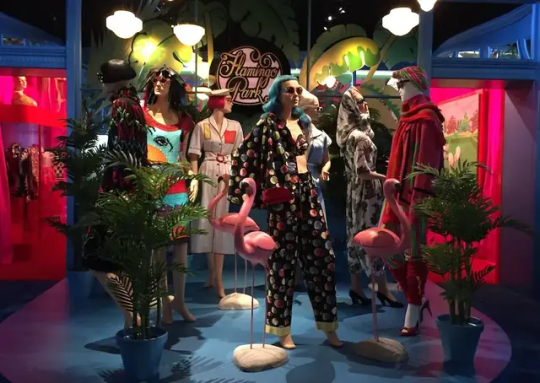
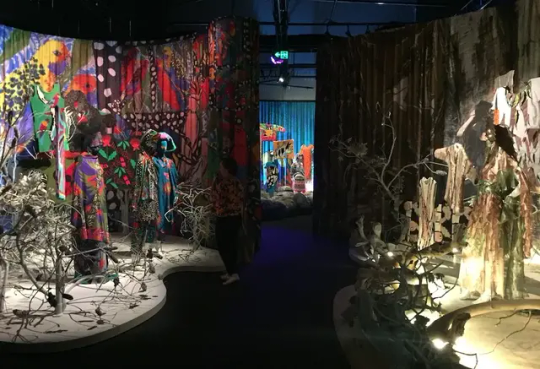
[3] Step Into Paradise (2019) [Exhibition] Powerhouse Museum, Ultimo. 17th October 2019 - 22nd March 2020.
Step Into Paradise (2019) is an exhibition that focuses on designers Jenny Kee and Linda Jackson, notable for their retail outlet Flamingo Park, established in 1973 in the Strand Arcade in Sydney where they sold not only the works of Jackson and Kee, but also other Australian designers like Peter Tully and David McDiarmid (Powerhouse Collection, N.D). Both designers are known for their distinctly ‘Australian’ style where many motifs and imagery of Australian nature and landscapes are featured in their garments. In addition to their designs being featured in their shop, Kee and Jackson also featured their designs in annual Flamingo Follies fashion parades with the help of collaborators. This exhibition is stated to be the “first major in-depth survey of the Australian designers and artists” (Fairley, 2019) with over 150 items including outfits, photographs, ephemera, and stories from over their four-decade career of “shaping an Australian narrative through fashion” (Fairley, 2019). Jackson and Kee’s work is displayed in a manner of different ways throughout the exhibition, with the viewer being taken through a series of rooms, accompanied with sound installations by Johnny Seymour and Nick Wales to create an immersive environment, each resembling a different part of the Australian Landscape including “the Great Barrier Reef, the Australian bush, opals and waratahs” (Fairley, 2019) and even a recreation of the Flamingo Park salon in which some of their most iconic designs like Kee’s I Love (1976)dress can be seen on display and embodies the working environment of the pair in addition to signifying the beginning of their iconic partnership. The display of both Kee and Jackson’s works together not only highlights their similarity in their use of Australian nature for inspiration but also showcases the different approaches they take in creating fashion as Kee’s designs consist of colourful knitwear whereas Jackson creates imagery and pattern using applique and patchwork in addition to the experimentation with the fabric using screen-printing, hand-painting and cut-work (Somerville, 2013). Visitors may also recognise some of the pieces that were on display as many of the duos works have been worn by popular designers like Karl Lagerfeld’s suit from the 1983 Chanel collection which featured Kee’s Black Opal print as well as British royalty as Princess Diana had previously worn the Blinky koala jumper which was knitted by Kee (Fairley, 2019). On the other hand, Jackson has created works for popular musicians like Marcia Hines (a hand-painted Gladioli dress) and has had her work featured in Vogue Living where Nell Schofield wore her Glacier Gown and Penguin Coat in Antarctica (Fairley, 2019). Overall, Step Into Paradise is an amazing example of how curators utilise retail settings associated with fashion, in this case it is Jackson and Kee’s history with their own salon, in order to help visitors to gain an insight into a designers surroundings and their creative mindset. Furthermore, by immersing their works into backgrounds directly related to the influences of their designs, the exhibition also does a great job of emphasising that not only are Jackson and Kee established designers but also artists.
You can find a walkthrough of the exhbition here.
0 notes
Text
The Krystyna Campbell-Pretty Fashion Gift
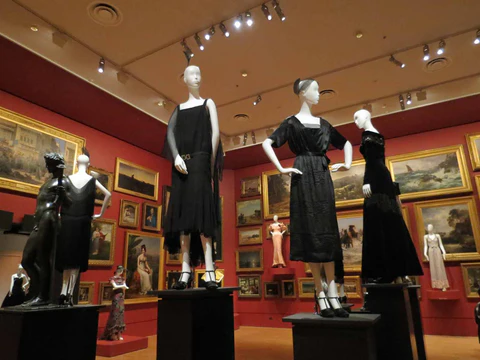
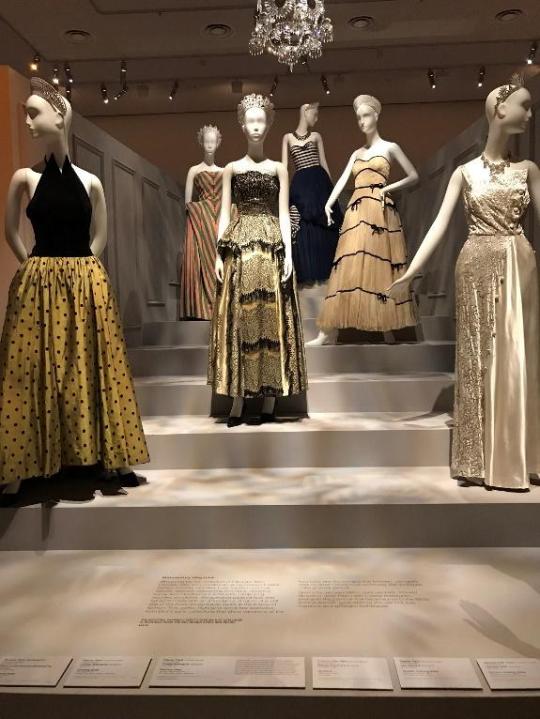
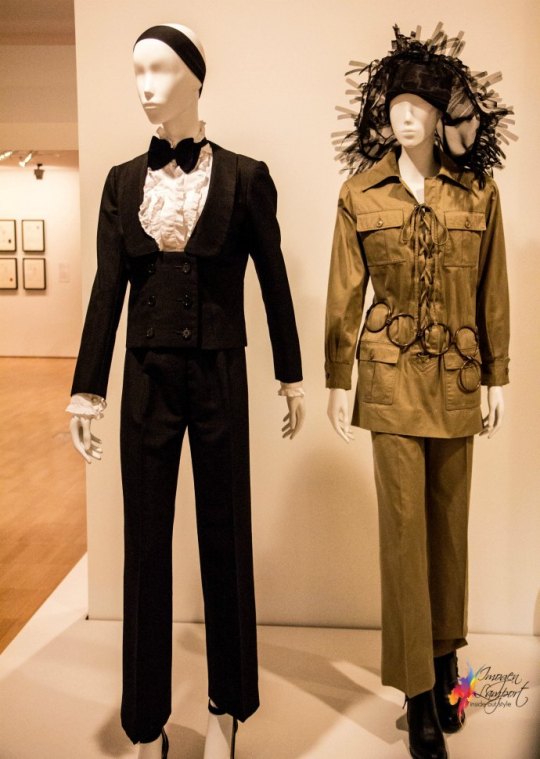
[4] [5] [6] The Krystyna Campbell-Pretty Fashion Gift (2019) [Exhibition] National Gallery of Victoria, Melbourne.
The Krystyna Campbell-Pretty Fashion Gift is an exhibition featuring some of the outfits donated by Krystyna Campbell-Pretty in memory of her husband, Harold Campbell-Pretty (National Gallery of Victoria, 2019). Displayed amongst the NGV’s permanent collection of 19th century paintings and sculptures (which also are displayed in a format similar to that of the french salon), the exhibition immediately signifies fashion’s importance as an art form and, with the garments all being womenswear throughout different parts of history, also delivers a feminist narrative given exclusion of women in art institutions how overlooked women were in the field of art during that period. The exhibition showcases over 200 garments collected by Campbell-Pretty that are representative of “the world of haute couture and Parisian fashion from the late nineteenth century to the twenty-first century” (National Gallery of Victoria, 2019) and features garments and archival works (including sketches, workbooks, photographs, magazines, journals and periodicals) from prominent designers like Charles Fredrick Worth (who some would consider as the ‘father’ of haute couture), Coco Chanel (including her iconic ‘little black dress’) and Alexander McQueen as well as many more. The fashion gift also highlights how museums are highly dedicated to establishing connections and relationships with others given how, due to the generosity of Campbell-Pretty and her support of the work of the National Gallery of Victoria, her donation has completely transformed the museum’s collection (National Gallery of Victoria). The further emphasis on fashion being viewed as art within this exhibition can also be seen through the techniques undertaken by the designers themselves, especially the works of Charles Fredrick Worth as although he took on the role of the designer, he still signed his works on the waistbands of his dresses similar to how an artist signs their own pieces. In the words of Campbell-Pretty herself, “fashion can be simultaneously artistic, pragmatic and a crucial physical record of complex construction skills and techniques that are all but gone” (Lampton, 2019). This exhibition is a good example of how institutions exhibit fashion as art in addition to allow audiences make connections into how fashion and art intersect with one another in the sense that they both also serve as a visual record of social changes and provide a commentary on social and political issues throughout history. It can also be said that this exhibition serves as another example of historical fashion exhibitions given the extensive documentation into designers’ different approaches and techniques in creating fashion and where their priorities lied depending on the context and what was happening during their time. This is further emphasised by Campbell-Pretty where she states that “for me, fashion is also visual and social history, reflecting the role, perception and lives of women in society” (Lampton, 2019).
You can find an overview of the exhibition (including an interview with Krystyna Campbell-Pretty) here.
0 notes